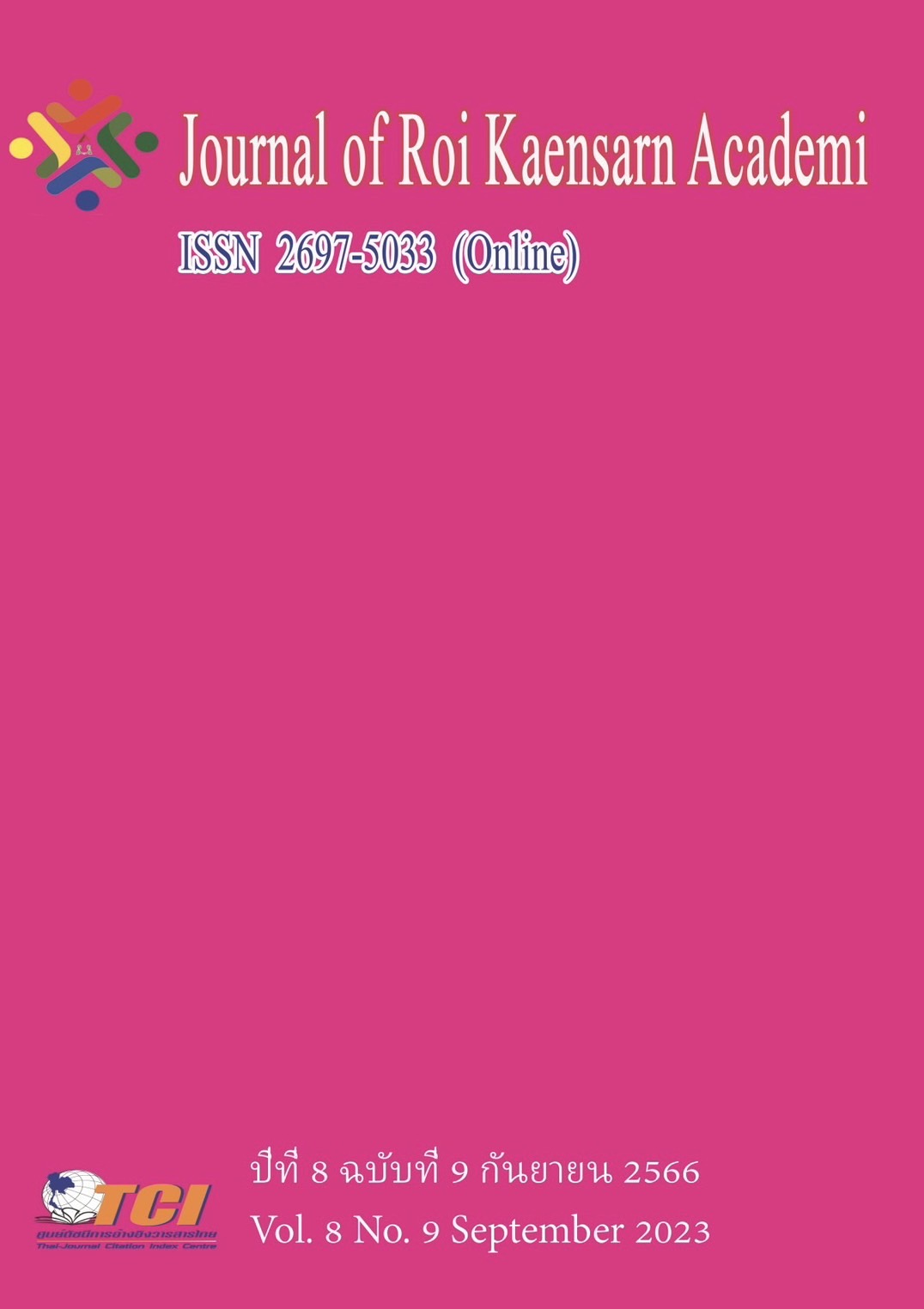Phenomenon-based learning Approach Promoting Scientific Literacy on the Buoyancy of Liquids for 8th Grade Students
Main Article Content
Abstract
This action research aimed to study 1) implementing the phenomenon-based learning approach on the buoyancy of liquids in a classroom and 2) the progression of students’ scientific literacy. The research participants were 11 eighth-grade students, and the instruments consisted of: 1) three lesson plans using the Phenomenon-Based Learning approach to promote scientific literacy; 2) teaching reflection forms; 3) student worksheets; and 4) a scientific literacy test. The data were analyzed using content analysis and the interpretation of student responses. This research found that implementing the phenomenon-based learning approach to promote scientific literacy needed four main steps. Firstly, students observe and select the phenomenon of interest together. Secondly, students ask questions and define problems by observing the phenomenon together. Thirdly, students use various learning processes through practice and self-discovery together. Finally, students and a teacher reflect on the implementation and evaluation of that study using authentic assessment. Later, the findings indicated the students’ progression in scientific literacy. Mostly, they had developed their competency in scientifically explaining phenomena, then scientifically interpreting data and evidence, and evaluating and designing scientific inquiry.
Article Details
References
จินดา พราหมณ์ชู. (2553). ผลของการใช้กิจกรรมการเรียนรู้บริบทเป็นฐานที่มีผลต่อผลสัมฤทธิ์ทางการเรียนวิชาเคมีของนักเรียนชั้นมัธยมศึกษาปีที่ 5. วารสารศรีนครินทรวิโรฒวิจัยและพัฒนา. 2 (1), 33-39.
นัฏฐา มิ่งสุข. (2562). การศึกษาความเข้าใจที่คลาดเคลื่อนเรื่องปัจจัยที่มีผลต่อแรงพยุงในของเหลวของนักเรียนระดับชั้นมัธยมศึกษาปีที่ 6. ศึกษาศาสตร์สาร มหาวิทยาลัยเชียงใหม่. 5 (2), 119–132.
พิมพลอย ตามตระกูล. (2564). การพัฒนาความฉลาดรู้ด้านวิทยาศาสตร์ เรื่องกรด-เบส ด้วยการจัดการเรียนรู้แบบใช้บริบทเป็นฐานรวมกับการใช้เทคโนโลยี สำหรับนักเรียนชั้นมัธยมศึกษาปีที่ 5 วิทยานิพนธ์ปริญญามหาบัณฑิต. บัณฑิตวิทยาลัย: มหาวิทยาลัยนเรศวร.
พงศธร มหาวิจิตร. (2560). นวัตกรรมการเรียนรู้จากฟินแลนด์. นิตยสารสถาบันส่งเสริมการสอนวิทยาศาสตร์และเทคโนโลยี (สสวท.). 46 (209), 40-45
รุ่งทิวา บุญมาโตน (2560). การวิจัยเชิงปฏิบัติการเพื่อพัฒนาการรู้เรื่องวิทยาศาสตร์เรื่องควาทน่าจะเป็นของนักเรียนชั้นมัธยมศึกษาปีที่ 5. วิทยานิพนธ์ปริญญามหาบัณฑิต. บัณฑิตวิทยาลัย: มหาวิทยาลัยนเรศวร.
วินัย เชาวน์วิวัฒน์, จิราวรรณ คํามา, และ กนกศรี ศรินนภากร. (2564). การศึกษาผลกระทบต่อสภาพฝนของประเทศไทยจากการเปลี่ยนแปลงสภาพภูมิอากาศโดยใช้เทคนิคปรับแก้ความคลาดเคลื่อนแบบสเกลเชิงเส้น. การประชุมวิชาการวิศวกรรมโยธาแห่งชาติครั้งที่ 26 The 26th National Convention on Civil Engineering วันที่ 23-25 มิถุนายน 2564. การประชุมรูปแบบออนไลน์.
สถาบันทดสอบการศึกษาแห่งชาติ (องค์การมหาชน) (2565). จำนวนผู้เข้าสอบ และคะแนนเฉลี่ยของผลการทดสอบ O-NET ชั้นมัธยมศึกษาปีที่ 3 จำแนกตามสังกัด. กรุงเทพมหานคร: สถาบันทดสอบการศึกษาแห่งชาติ (องค์การมหาชน).
สถาบันส่งเสริมการสอนวิทยาศาสตร์และเทคโนโลยี. (2563). แผนปฏิบัติการเชิงกลยุทธ์สถาบันส่งเสริมการสอนวิทยาศาสตร์และเทคโนโลยี(สสวท.) ประจำปีงบประมาณ พ.ศ. 2562 – 2565(ฉบับทบทวนปีงบประมาณ พ.ศ. 2563. กรุงเทพมหานคร: สถาบันส่งเสริมการสอนวิทยาศาสตร์และเทคโนโลยี.
สถาบันส่งเสริมการสอนวิทยาศาสตร์และเทคโนโลยี. (2561). ผลการประเมิน PISA 2015 การอ่าน คณิตศาสตร์ และวิทยาศาสตร์ . กรุงเทพมหานคร: สถาบันส่งเสริมการสอนวิทยาศาสตร์และเทคโนโลยี.
สถาบันส่งเสริมการสอนวิทยาศาสตร์และเทคโนโลยี. (2561). ผลการประเมิน PISA 2015 วิทยาศาสตร์ การอ่าน และคณิตศาสตร์ ความเป็นเลิศและความเท่าเทียมกันทางการศึกษา. กรุงเทพมหานคร: ซัคเซสพับลิเคชัน.
สถาบันส่งเสริมการสอนวิทยาศาสตร์และเทคโนโลยี. (2560). จุดอ่อนระบบการศึกษาไทย FOCUS ประเด็นจาก PISA. ออนไลน์. สืบค้น 13 สิงหาคม 2565. แหล่งที่มา: www. pisathailand.ipst.ac. th/issue-2017-17
สถาบันส่งเสริมการสอนวิทยาศาสตร์และเทคโนโลยี. (2564). ผลการประเมิน PISA 2018 การอ่าน คณิตศาสตร์และวิทยาศาสตร์. กรุงเทพมหานคร: สถาบันส่งเสริมการสอนวิทยาศาสตร์และเทคโนโลยี.
สุนีย์ คล้ายนิล. (2555). การศึกษาวิทยาศาสตร์ไทย:การพัฒนาและภาวะถดถอย. กรุงเทพมหานคร: สถาบันส่งเสริมการสอนวิทยาศาสตร์และเทคโนโลยี.
อรพรรณ บุตรกตัญญู. (2561). การเรียนรู้โดยใช้ปรากฏการณ์เป็นฐานเพื่อการสร้างมุมมองแบบองค์ รวมและการเข้าถึงโลกแห่งความจริงของผู้เรียน. วารสารครุศาสตร์. 46 (2), 348–365.
อํานวย เดชชัยศรี, และคณะ. (2539). กระบวนการกลุ่ม. กรุงเทพมหานคร: โรงพิมพ์ศาสนา.
Kompa, J.S. (2017). Remembering Prof. Howard Barrows: Notes on problem-based learning and the school of the future. online. Retrieved 17 April 2023. form https:// joanakompa.com/tag/phenomenon-based-learning/
Nuora, P., & Välisaari, J. (2019). Kitchen chemistry course for chemistry education students: influences on chemistry teaching and teacher education – a multiple case study. Chemistry Teacher International. 2 (1), 1–10.
Butkatunyoo, O. (2018). kānrīanrū dōi chai prākottakān pen thān phư̄a kānsāng mummō̜ng bǣp ʻong rūam læ kān khaothưng lōk hǣng khwām čhing khō̜ng phū rīan [Phenomenon based Learning for Developing a Learner’s Holistic Views and Engaging in the Real World]. Journal of Education Studies. 46 (2), 348–65.
Symeonidis, V., & Schwarz, J. F. (2016). Phenomenon-Based Teaching and Learning through the Pedagogical Lenses of Phenomenology: The Recent Curriculum Reform in Finland. Forum Oświatowe, 28 (2), 31–47.
Viviana, N., & Anna, D. (2018). What, why, and how of phenomenon-based learning. online. Retrieved 25 April 2023. from https://www.onatlas.com/ phenomenon-based learning.

